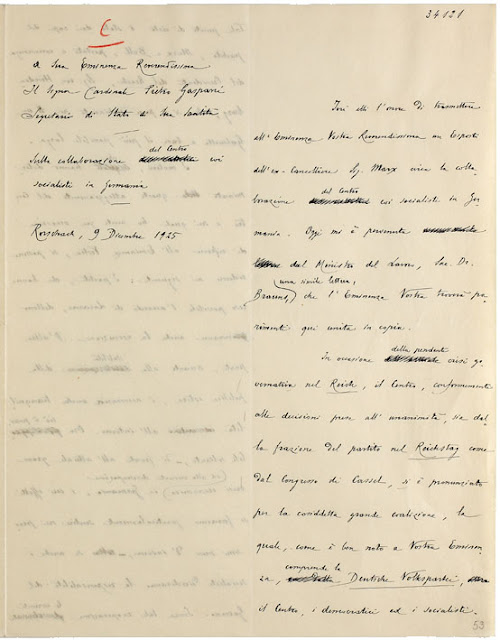Venanzio l'Eremita
Beato Ambrogio Traversari
c. 1618 -1659
Visitors to Florence are familar with the Convento of San Marco, the Dominican convent attached to Santa Maria Novella as well as the Franciscan Santa Croce.
They attract tourists in their thousands.
However there were other celebrated and powerful convents in the city and one of these was Santa Maria degli Angeli (St. Mary of the Angels) which belonged to the Camaldolese congregation
Part of this huge complex now houses some departments of the University of Florence. The rest has been demolished and built upon
Amongst others it housed the artist Lorenzo Monaco (Piero di Giovanni) (ca. 1370 - 1423/24)
A contemporary of Lorenzo Monaco was Ambrogio Traversari (1386 – 1439) who became Prior of the Convent and General of the Congregation. In Tuscany he has the rank of Blessed
He was one of the order of the Camadolese whom Pope Benedict XVI recently celebrated in Evening Vespers earlier this month
He was a great reformer of his order. He was also one of the great humanists of his day. Unlike the secular and classical humanists, his humanism was based on the works of the Great Fathers of the Church, patristic humanism
He taught himself Greek and achieved such an ascendancy in the study of the Classics he achieved a European renown.
He participated in the great discussions of the Florentine intelligentsia, which were hosted at Santa Maria degli Angeli, Traversari, Niccoli, and Marsuppini came to form the core of the intellectual circle surrounding Cosimo and Lorenzo de‘ Medici, It was a mecca for humanists, statesmen, prelates, and visiting literary figures.
Traversari was responsible for the acquisition of many Greek texts from the East which had hitherto been unknown in the West. More importantly he translated these texts into Latin. It is generally recognised that his translation of nineteen sermons of Saint Ephrem the Syrian ("the blessed deacon of Edessa) (ca. 306 – 373) was almost certainly the first of any of St Ephrem’s works to be printed in any language. St Ephrem was proclaimed a Doctor of the Church in 1920 by Pope Benedict XV
He was a great supporter of the Pope and the primacy of Peter when Conciliarism was at its height. He was one of the Pope`s legates at the Council of Basel and one of the Pope`s strongest supporters and then when it was transferred to Ferrara and later to Florence
Traversari had an important role in the Council. He wrote to a fellow monk:
"It is I who do all this business of the Greeks, translating from Greek into Latin or from Latin into Greek all that is said or written" (Gill Council 118).
His mother was very sick during the council, and at one point he took 15 days off to spend with her; the council was not able to proceed in his absence, and he was ordered back.
He helped draft the Council`s decree of reunion "Decretum Unionis" (Laetentur Coeli)
The art historian Richard Krautheimer suggested that one of the doors made by Lorenzo Ghiberti, 1425-52 for the Baptistry of the Duomo (being made while the Council was taking place in Florence) depicts in allegorical form the wedding or union of the two Churches: Salomone e la regina di Saba (Solomon and the Queen of Sheba)
He went on to suggest that one of the figures depicted in the bronze scene was that of Trevarsari.
Unfortunately this story although a good story has been well and truly debunked by the art historian E.H. Gombrich in Topos and Topicality Annual Lecture of the Society for Renaissance Studies, delivered at University College, London, 10 January, 1975
Traversari died in the year of the Council`s decree. He did not live to see the dissolution of the Union which for him would have represented a catastrophe to his vision of the Church. But despite the dissolution, the Union was a recognition of the importance of the Papacy
We may not know what Traversari was like but we can enjoy and appreciate a work which he commissioned hor his Convent. The work The Last Judgment was by another Blessed, Blessed Fra Angelico, now in the Museo nazionale di San Marco, in Florence
Blessed Fra Angelico 1400 - 1455
The Last Judgment
c. 1431
Tempera on wood
105 × 210 cm
Museo nazionale di San Marco, Florence
Of this painting, Vasari said:
"[I]n the Church of the Monks of the Angeli he made a Paradise and a Hell with little figures, wherein he showed fine judgment by making the blessed very beautiful and full of jubilation and celestial gladness, and the damned all ready for the pains of Hell, in various most woeful attitudes, and bearing the stamp of their sins and unworthiness on their faces. The blessed are seen entering the gate of Paradise in celestial dance, and the damned are being dragged by demons to the eternal pains of Hell. This work is in the aforesaid church, on the right hand as one goes towards the high-altar, where the priest sits when Mass is sung."
It was a work which set a new paradigm for the depiction of its theme and which lasted until Michelangelo completed his great project in The Sistine Chapel



































